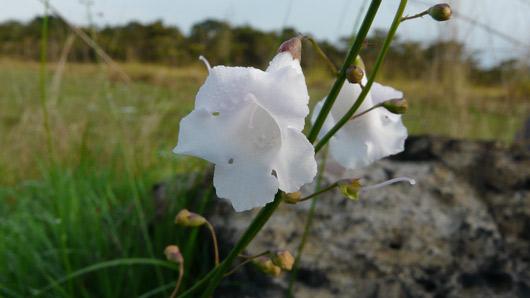Geography and distribution
Micrargeriella aphylla was previously thought to be restricted to Zambia, where it has been recorded both in the north-east and north-west of the country. Its discovery in north-east Angola significantly extends its known range. It is also likely to be found in the wet grasslands of southernmost Democratic Republic of Congo, however, much of this region remains under-explored botanically.
It is a species of seasonally wet grasslands, but Kew botanists noted that in Angola it was always found growing either around small rock outcrops or at the foot of the bizarre, mushroom-shaped termite mounds that dot the wet grasslands of this region.
Description
Micrargeriella aphylla is an erect, perennial herb, growing up to 50 cm tall. The stem base is woody and fire-resistant and produces wiry and rather brittle, often unbranched, annual green stems with minute, scale-like leaves 2-3 mm long. These are held close to the stem and are arranged alternately.
Flowers are held in a loose spike of 15, each on a stalk typically 1 cm long with a pair of minute bracteoles (modified leaves) about midway. The calyx (whorl of sepals) is bell-shaped, 2-3 mm long with five short lobes. The corolla (whorl of petals) is white or palest pink, 1.5-2.0 cm long, with a broad, swollen tube and five spreading lobes. The four stamens (male parts) are held within the corolla tube, whereas the style (female part) extends beyond the lobes and curves downwards at the tip.
The fruit is a many-seeded capsule, 4 mm long.
Parasitic relationship
As with many species in the Orobanchaceae family, Micrargeriella aphylla is a root parasite.
Since it is largely leafless, it appears to derive most of its nutrients in this way, although it is not entirely parasitic, having green stems for photosynthesis (uses sunlight and the green pigment chlorophyll to make nutrients from carbon dioxide and water). It is unknown which plant species it parasitizes, although in Angola it was found in association with grass and sedge species.
Threats and conservation
Micrargeriella aphylla was assessed as Vulnerable (VU D2) in the Zambian Red Data List of Plants on account of its restricted range. It is a scarce species, known from only five sites in Zambia and one in Angola. However, parts of its range remain poorly studied botanically and other sites are likely to be discovered in the future.
From observations of Kew botanists in Angola, where M. aphylla was seen growing plentifully at a single site, it appears to require seasonally wet grassland that is burnt after the rainy season. These 'dambos' are widespread across north-east Angola and northern Zambia, being found in areas of impeded drainage such as floodplain depressions.
Dambos are traditionally used by local human populations for a variety of purposes including subsistence agriculture, fishing, hunting, thatching materials and clay for building and as a dry-season water source. However, many of these activities are small scale and so the level of disturbance may not greatly threaten M. aphylla . Certainly at the Angolan site, although local populations used the dambo site, disturbance was low and did not appear to have an adverse effect on M. aphylla .
This species at Kew
Dried and alcohol-preserved specimens of Micrargeriella aphylla are held in Kew's Herbarium where they are available to researchers by appointment. These include a collection from the April-May 2011 expedition to Angola.
Assessing plant conservation priorities in Angola
Kew is participating in a multi-national, multi-disciplinary project that aims to identify priority sites to expand the protected areas network in Angola. Kew is leading the botanical aspects of this work, in collaboration with partners in Angola. The expedition to the Lagoa Carumbo region of Lunda Norte, north-east Angola was the first in a series of biodiversity assessments to provide data to support this programme.
The flora of Angola is rich, with a wide variety of habitats and several regions of high species diversity and high numbers of endemic species (those found only in Angola). However, it also remains one of the least well botanically studied countries in Africa. There is therefore a great need to carry out plant survey work and vegetation studies throughout this exciting country.

